Bipin Pharma Equipement
Product Range
Fact Sheet
- Location:Maharashtra, India
- Year of Establishment:1995
- Business Type:Manufacturer, Exporter
- Main Products:Filter Press, Colloid Mill
- Reviews & Rating:
Get Verified, Sell more with
- Buyer's trust
- Faster conversions
- Better Rankings
- More
Its Free
Verify NowVaccum Tray Dryer
Vacuum Tray dryer is the most commonly used batch dryer. They are box-shaped and loaded and unloaded via a door (two doors on the larger models).
- FOB PriceNA
- Min Order QuantityNA
- Payment TermsNA
Other Details
Vacuum Tray dryer is the most commonly used batch dryer. They are box-shaped and loaded and unloaded via a door (two doors on the larger models). Inside are several heating plates mounted one above the other on which the product is placed in trays. The bottoms of both heating plates and trays should be as smooth as possible to permit optimal heat transfer between plates and product. The medium flowing through the heating plates is water, steam or thermal oil. The distance between the heating plates is determined primarily by the surface loading and the foaming of the product. To void retrograde condensation the cabinet walls are indirectly preheated by the heating plates. Next, the product is introduced and heated at atmospheric pressure. Only after all individual product trays reach the same temperature the cabinet is evacuated and drying can start. The preheating phase is very important in order that the drying curve and the foaming of the product is identical throughout the cabinet. During the main drying phase the vacuum is in the range of 40 to 80 mbar abs and in the final drying phase vacuums of only few mbar abs are reached. Heating temperatures are normally in the range between 800C and 1100C. Depending on product and surface load, drying takes from a few hours to 1 to 2 days. For some products the vacuum and temperature profiles are automatically controlled in order to prevent a pass over of the critical product temperature.
The dimensioning of the vacuum system is an important factor in the design of drying cabinet systems. If for example vigorous foaming of the product is desired, evacuation to the operational vacuum level must take place very quickly. Vapors produced during drying are taken out direct, or via a steam jet compressor to a surface condenser in which the vapors condensate. The non-condensable vapors are extracted by the vacuum system.
On completion of the drying, the product can be cooled by circulating of cooling water through the heating plates.
Features:
All contact parts are made out of SS304 / SS316 / SS316L quality material in GMP models and mild steel externals with stainless steel internals in standard model
Hollow pad type heating shelves which are easily removable for maintenance
Condenser and condensate receiver fixed on the dryer body or stand alone for remote installation
Full welded skirt on vacuum dryer body for flush mounting through the wall.
External fluid heating of dryer with protective panels in stainless steel or mild steel powder coated
Dedicated fluid heating and circulating systems. These can be steam or electrically heated. Fluid heating systems are available for water as well as thermic fluid (for temperature requirements above 95 oC)
Validation ports and nitrogen purge nozzles
Can be designed to customers specification requirements
Steam sterilisable models available
Double door loading available for large models
Halar lined internals for corrosive applications
Technical Specifications
| Model | VTD 6 | VTD 12 | VTD 18 | VTD 24 | VTD 36 | VTD 48 | VTD 96 |
| Capacity in Trays | 6 | 12 | 18 | 24 | 36 | 48 | 96 |
| Number of Shelves | 6 | 6 | 6 | 8 | 12 | 16 | 32 |
| Dummy Shelf | 1 | 1 | 1 | 1 | 1 | 1 | 2 |
| Trays Per Shelf | 1 | 2 | 3 | 3 | 3 | 3 | 3 |
Images






